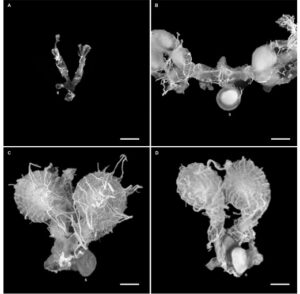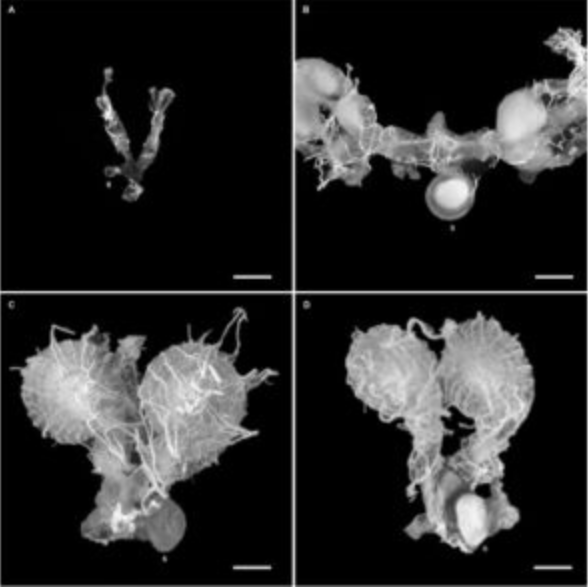Monarchies may be outdated – unless you’re a bee
Insect societies are some of the most complex known to science. Indeed, the insect groups best known for their social success – ants, bees, wasps and termites – are perhaps the only animals that rival humans in the sheer scale of the societies they form. Insect societies may comprise millions of individuals and cover huge geographical areas. The majority of southern Europe is covered by a single colony of Argentine ants – and this same colony has offshoots in the US and Japan. For such large societies to exist, cooperation is key – each individual has a role to play, and what that role is is dictated by how the society is structured and where each individual falls within it.
The majority* of insect societies that most people are familiar with come from the order Hymenoptera, the ‘membrane-winged’ insects – ants, bees and wasps are all from this group. And if there’s one thing everyone knows about these insects, it’s that they have something solitary insects do not: queens. But what is an insect queen anyway, and what are they for?

Hymenopteran social structure
First, a refresher on sex-determination in Hymenoptera. All Hymenoptera, social or otherwise, exhibit haplo-diploid sex determination. Eggs need to be fertilised to become female, otherwise they develop as male. Thus all females (ie. workers and queens) have the ability to lay eggs, but will only be able to lay male eggs unless they have mated** – and only queens can mate.
Hymenopteran societies consist of three castes – queens, workers and males (sometimes called drones). Queens and workers are female. Their roles within their societies can be inferred from their names. Workers work: they care for the queen, forage for food, guard the hive from enemies, take care of larvae and young bees, and keep the place clean and tidy. They do not engage in sexual activity, and (usually) do not reproduce. Males are purely for sexual reproduction, doing no work, relying on workers for food and care. They are essentially ‘sperm with wings’; they are largely helpless on their own and spend their lives awaiting the (oft-unfulfilled) opportunity to mate with a queen. And this brings us to queens themselves.
Who’s really in charge?
Queens have one job: to make more bees. The notion that queens are somehow in charge of their colonies is a misconception. Queens are vital – they are the only individuals capable of producing workers, and without workers, the colony cannot function. Queens are essentially egg factories. While workers closely guard and lavishly care for their queens, they also constantly monitor her egg-laying rate. If the queen’s egg-laying rate drops below the level which can maintain the colony’s population, the workers immediately and mercilessly replace her. The old queen is exiled to the outskirts of the colony, or outright executed. Several larvae are reared as new queens, one of whom will inherit the colony.
When all hope is lost
So what happens if the new queen also becomes sick or dies, and the colony is unable to rear another? This situation is known as hopeless queenlessness, and without intervention by beekeepers, will inevitably result in the colony’s death. The worker population will dwindle, and without the essential tasks they complete, the colony collapses within a matter of weeks. When all hope is lost, the colony has one last backup plan – the remaining workers will activate their ovaries and lay eggs. These eggs will develop as males and will have the chance to mate with a queen from another colony – thus allowing the doomed colony one last chance to pass on its genes and preserve its genetic legacy.
This strategy is known as facultative worker sterility, and occurs in all honey bee species. But while honey bees are the best-studied of the social Hymenoptera, we should never assume that what applies to them applies to all. A case in point: the Australian stingless bee, Tetragonula carbonaria.

Absolutely sterile workers
T. carbonaria differs markedly in many ways from honey bees, but the basic social structure is the same: colonies consist of an egg-laying queen, thousands of workers, a few males and usually, a few virgin queens. Similarly to honey bees, queens lay eggs, workers work, males mate. One important difference however is this: workers never, under any circumstance, lay eggs (Gloag et al., 2007; Nunes et al., 2014).
T. carbonaria workers never laying eggs caught the BEE lab’s attention for several reasons. Firstly, it’s weird: in almost all the social Hymenoptera, there are situations in which workers will lay eggs. Secondly, what do they do if they become hopelessly queenless?
Will T. carbonaria workers lay eggs if given the chance?
The BEE Lab’s Francisco Garcia Bulle Bueno set out to investigate this question. Garcia Bulle Bueno and colleagues created ‘microcolonies’ – miniature but fully functional colonies of T. carbonaria (Garcia Bulle Bueno et al., 2020). They then placed the workers in these colonies under conditions that, in any other social Hymenopteran, would stimulate workers to lay eggs.
First, all the microcolonies were queenless. Remember that in honey bees, if workers are in queenless conditions for longer than a week or two, they will begin to lay eggs. Secondly, workers in half of the microcolonies were fed a steady diet of royal jelly (Garcia Bulle Bueno et al., 2020). The other half were fed a typical bee diet of pollen and honey.
Royal jelly is what allows queens to become sexual while workers remain asexual. Royal jelly contains important fatty acids and is high in protein. When fed to larval honey bees, they develop as queens rather than workers. When fed to adult honey bee workers, it causes them to activate their ovaries. Interestingly, this effect is apparent across insect-kind: female fruit flies, crickets and silkworms all become reproductively active after eating honey bee royal jelly.
Garcia Bulle Bueno et al. collected workers from each microcolony at the start of the experiment and again after 14 days on their respective dietary regimes. All microcolonies were queenless throughout the experiment. The collected workers were then dissected to compare rates of ovary activation.
Irreversible sterility
Interestingly, Garcia Bulle Bueno and colleagues found no evidence of ovary activation in either the royal jelly-fed bees or the control group. Regardless of food source, workers had degenerated and deactivated ovaries – despite being separated from a queen throughout this time. They also found that workers newly emerging from pupation had non-functional ovaries that contain no germ cells. This leads to one conclusion: T. carbonaria are absolutely incapable of reproduction, regardless of circumstances or diet. By the time they are adults, their ovaries, while present, have degenerated to the point that they can never be activated. They are irreversibly sterile – and only the second example of a bee species with irreversibly sterile workers that is currently known. The other is also a stingless bee – the South American genus Frieseomelitta.

T. carbonaria never loses hope
If T. carbonaria workers never lay eggs, what does the colony do if it becomes hopelessly queenless? Garcia Bulle Bueno and colleagues suspect that the primary reason T. carbonaria workers have lost the ability to lay eggs is because their colonies never do become hopelessly queenless.
Honey bees only rear new queens in certain situations: if the current queen is suddenly lost, or if the colony is about to swarm. At all other times, there is only one queen in the colony. Unlike honey bees, T. carbonaria colonies are constantly producing new queens, even if their current queen is healthy and productive. There are always virgin queens around, and so if anything should happen to the current queen, there are ready and willing replacements immediately available to fill her spot. Since the colony never has to go long without a queen, workers never need to lay eggs – and so their ability to do so has been lost (Garcia Bulle Bueno et al., 2020).
This result is highly significant. It provides yet another example that evolution doesn’t just add traits, but also trims traits that are no longer advantageous. More importantly, it shows how different societies have evolved alternate strategies to tackle the same problem. Rather than being a leader, a queen is a vital resource to a colony; she is the only thing ensuring its survival. If she’s gone, the colony still needs to fulfil its evolutionary imperative to get its genes into the next generation. Honey bees do this via worker-produced males; stingless bees seem to avoid the problem completely by always having virgin queens on hand. Further research is needed to know what other contingency plans may be being used by different species in the event that the queen is lost.
*Readers will also be familiar with termites, the other highly successful group of social insects. Termites are part of the order Blattodea and are basically social cockroaches – this may increase or decrease your appreciation of them.
**Except for thelytokous species.
Further reading:
Garcia Bulle Bueno, F. et al. (2020) ‘Irreversible sterility of workers and high-volume egg production by queens in the stingless bee Tetragonula carbonaria‘. Journal of Experimental Biology, In press. DOI: 10.1242/jeb.230599
Gloag, R. S. et al. (2007) ‘No worker reproduction in the Australian stingless bee Trigona carbonaria Smith (Hymenoptera, Apidae)’, Insectes Sociaux 54, 412–417.
Nunes, T. M. et al. (2014) ‘Queen signals in a stingless bee: suppression of worker ovary activation and spatial distribution of active compounds’, Scientific Reports 4, 7449.
